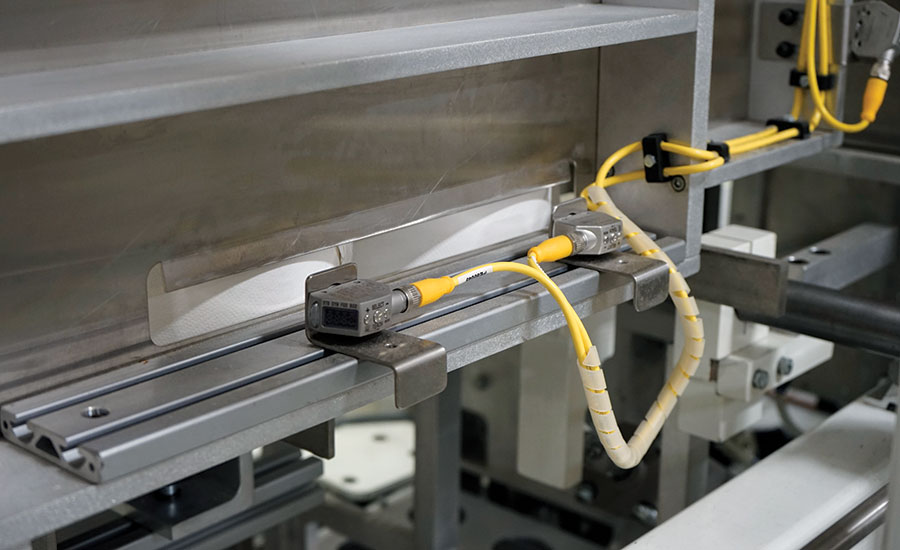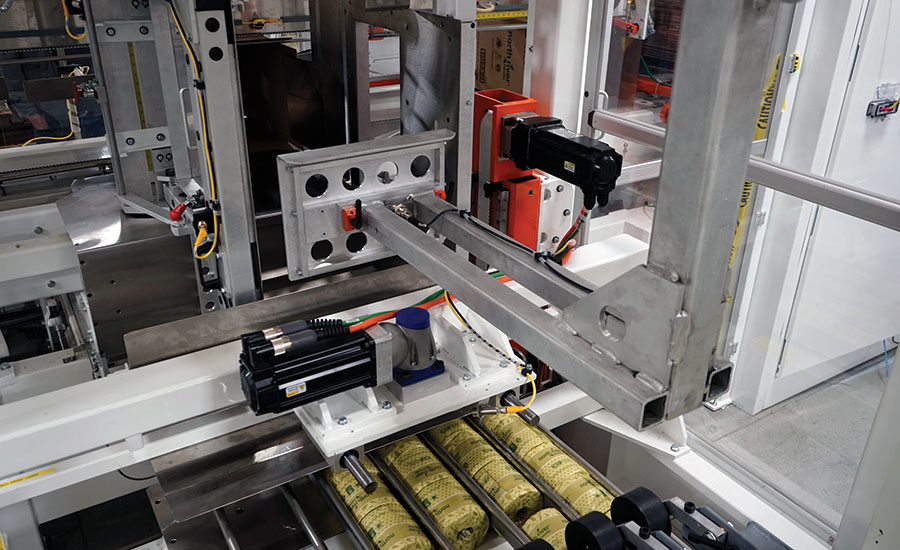IO-Link is a revolutionary, cost-effective sensor and actuator standard that can today enhance the flexibility, capabilities and productivity of packaging machines both new and already in use with little extra burden on operators or maintenance personnel. In fact, it makes their jobs easier.

IO-Link is based on the first international standard for IO technology IEC 61131-9. This standard has the enthusiastic support of the major automation companies from sensor and actuator manufacturers to controls suppliers. This means that new IO-Link enabled sensors and actuators are coming to market rapidly, and that the supplier community is supporting original equipment manufacturers (OEMs) as they incorporate the standard into their packaging machines. The following three examples of applications on Edson (edson.com) case packers illustrate the practicalities of IO-Link.
How IO-Link Helps Case Packers on the Line
For many years, Edson utilized radio-frequency identification (RFID) tags on change parts. Machine-mounted tag readers verified the correct change part was in position for an upcoming SKU. The case packers would not run with a wrong part installed. Each RFID reader was hardwired back to an I/O card and was capped at less than 255 read only RFID tags due to limited panel space and I/O availability. On occasion, a customer wanted to add change parts for a new SKU. The problem, in the past, was that this entailed additional sensors, multiple wires per sensor and an increase of I/O cards that had to be incorporated into an already tightly packed control cabinet. Expanding the system posed issues.

Now, with IO-Link, a single Standard Shielded sensor cable runs to an enabled RFID reader. Each reader can handle more than 255 tags and can write to the tags, as well. The amount of data transfer is exponentially higher than before. No additional cabinet space is required to add readers because IO-Link components connect via Standard Shielded sensor cable to an IO-Link Master, a plug and play IP67 rated adapter that can be mounted to the machine. The IO-Link cable can be up to 20 meters long, so distance between component and IO-Link Master isn’t typically a hurdle.
The Edson case packer’s controller now tracks the cycles of each change part for preventive maintenance purposes. It is fast, simple and cost effective to add readers to an existing machine. If a reader fails, the controller senses the failure, identifies the exact reader and alerts maintenance personnel to the location through the human machine interface (HMI). Diagnostics are a big part of IO-Link. Furthermore, maintenance personnel only need to physically install the sensor. There is no manual configuration required. This is one of the best features of IO-Link – automatic configuration of components via PLC. Automatic configuration is true of all IO-Link sensors. Customers like the fact that sensor settings are protected through the HMI. An inadvertent or incorrect change to sensor settings by personnel is a thing of the past.
Edson utilizes IO-Link enabled laser sensors located in a case loading magazine to give analog feedback on the exact location of the next case to be picked up. Accuracy is within + .04 inches (1mm). This level of accuracy, which was not cost effectively achievable before, leads to more precise case handling and the elimination of jams due to inaccurate distance readings. These sensors can also detect slope variation in a stack of cases. Large variation identifies cases that are out of specification. The system alerts operators before a jam occurs.
In addition, Edson applies IO-Link enabled photo-eye sensors in locations on a case packer particularly susceptible to dust build up, i.e. sensors facing vertically and/or on machines destined for high particle environments, such as paper packaging plants. With IO-Link, operators receive information on the exact location of any photo-eye lens that is becoming covered in dust. This information helps keep the machine operating at peak performance and ultimately means less time spent by maintenance personnel trying to diagnose the cause of a stoppage.
There are practical benefits of IO-Link, not only for case packers but every packaging machine:
- Smart changeover on the fly – replace the sensor and the controller does the rest
- Self-diagnostics alerts operators to a problem and pinpoints the sensor and the issue for faster troubleshooting
- A wider variety of sensors for greater capabilities than before
- No added burden for the operator; in fact, IO-Link enables operators to keep the machines at peak uptime
- Personnel cannot inadvertently change a sensor setting and cause an operational problem
- Faster installation of new machines with less wiring
- Practical and cost effective to upgrade to IO-Link sensors in many cases
- Decrease in hardware when communicating via Ethernet
- IO-Link and non-IO-Link sensors can exist on the same machine on the same network so OEMs can drill down for the optimum mix for price and performance.
A Look Ahead to the Industrial Internet of Things and IO-Link
Visualize a future where a control center, either in a plant or at a corporate facility responsible for many operations, is staffed by highly trained personnel. These control centers will have web-based access to every production machine down to the sensor and actuator level. Sophisticated algorithms – perhaps artificial intelligence – monitor machine condition. Information on such conditions as dust on a photo-eye lens, a stuck actuator or a servo motor heating up is immediately available to control center staff. Alerts in the form of text messages are dispatched automatically to the mobile device of an on-call maintenance technician, pinpointing the exact problem and location. Control room staff is available with informational backup, including vendor information and availability of onsite replacement parts. This scenario is possible today and will undoubtedly be common tomorrow. A key enabling technology of this capability is IO-Link with sensors and actuators individually accessible through Internet-based communications – the very foundation of the Industrial Internet of Things.
Authors:
Barry Sonny is a veteran electrical control designer for industrial automation equipment with Edson Packaging Machinery. He has implemented numerous IO-Link Master and IO-Link enabled devices for case packing machinery.
John Whiting is an experienced controls programmer at Edson Packaging Machinery with designing, testing, building and servicing skills. He has extensive knowledge in the development of new automation equipment and automation upgrades for existing equipment.
Reprinted with permission from Packaging Strategies, Copyright 2017, www.packagingstrategies.comhttp://www.packagingstrategies.com
